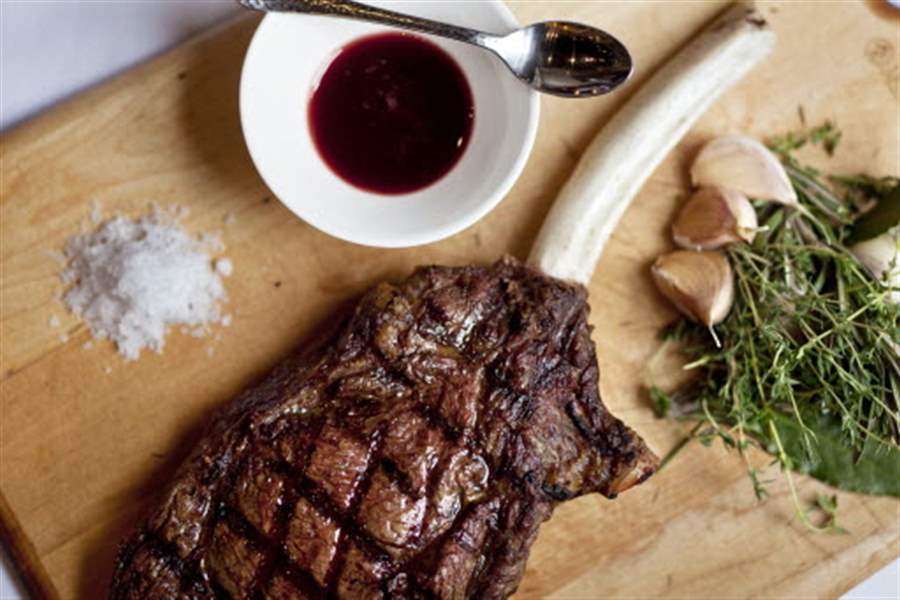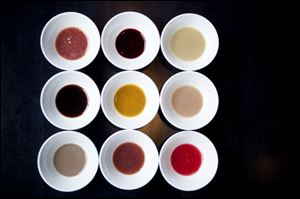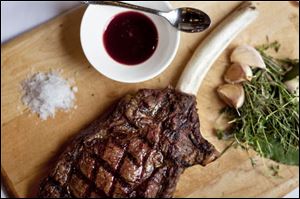
Modern ketchup has come full circle
8/16/2011
A bison steak served with cherry ketchup.
NEW YORK TIMES

A variety of ketchups at Jose Andres’ restaurant, America Eats Tavern. Left to right top row, blueberry, blackberry, oyster; left to right middle row, mushroom, yellow tomato, gooseberry; left to right bottom row, anchovies, spice berry and red currant.
"Everyone else in the world still thinks of American food as ketchup," said Mr. Andres, who was born in Spain but has been living and cooking in Washington for 20 years.
He said that European colleagues still tease him about finding success here, among diners whose palates are corrupted by ketchup. The low prestige of ketchup hits Mr. Andres hard.
Now he is on a quest for redemption. He (and a few other chefs and entrepreneurs) are challenging the hegemony of the red, corn-syrup-sweetened product.
"It is time to embrace and celebrate ketchup, not be ashamed of it," he said.
And so his new pop-up restaurant, America Eats Tavern, has a separate menu of traditional ketchups, made from local and foraged ingredients and served on everything from fried chicken to bison steak to hot dogs.
The restaurant opened in June, and grew from an exhibition at the nearby National Archives that runs through January. "What's Cooking, Uncle Sam?" illustrates the history of government influence on the American diet, from handwritten rations for Revolutionary War soldiers (one pound each of beef and bread per day) to the ill-starred 1981 proposal by the Department of Agriculture to reclassify ketchup as a vegetable in federal school-lunch programs.
Last week, the restaurant had eight ketchups on the menu and still more fermenting in the mind of Jorge Luis Hernandez, who leads Mr. Andres' culinary research team. Hernandez said that in searching the archives, the team found dozens of ketchup recipes in tomes like Miss Beecher's Domestic Receipt Book (1846) and The Virginia Housewife (1824).
"Today we think of ketchup as just one thing: Heinz, or Hunt's, for those of us who grew up in the South," he said.
But over the years, the term has been used for a variety of strongly seasoned condiments.
"We started making whortleberry and barberry and oyster ketchup from the original recipes," Mr. Hernandez said, "and we were shocked by how diverse and modern the flavors were." Indeed, the tart-sweet balance of the fruit ketchups, and the cold brininess of the oyster version (fresh oysters blended into a base of wine, butter, shallots, and mace) could have come out of any of the professional kitchens in France where Mr. Andres first trained as a chef.
Some of the ketchups were red (cherry and spiceberry), one was made from tomatoes (yellow) and two (oyster and anchovy) were brightly fishy. They tasted of spices and fruit, of peppercorns and vinegar, but not particularly like the syrupy tomato blast that has come to represent America's primary contribution to world cuisine, whether Americans like it or not.
"Why, as a society, have we let this diversity go away?" Mr. Andres lamented via cellphone from Spain -- where, he said, it would be unthinkable to find just one version of a classic sauce like romesco. "Why would we go from a rainbow to black and white?"
American foodies and chefs generally dismiss ketchup, deeming it fit only for children and burgers.
The apotheosis of ketchup shame is the gastropub Father's Office in Santa Monica, Calif., a serious burger town where condiments, especially mayonnaise, are deeply loved. Chef Sang Yoon's Office Burger, and its salty-sweet topping of bacon and caramelized onions, is the centerpiece of his menu. Yet since opening in 2000, he has refused to serve ketchup with it, or with anything else in the restaurant.
Many residents remain irritated by what they see as the chef's snobbery, and some have maintained a boycott.
"My wife would not go until this year, when I begged her to go with me on Father's Day," said Cesar Ramirez, who lives in Hacienda Heights, Calif. To appease her, he smuggled in some packets of Heinz and put it on the sweet-potato fries, then posted pictures of the contraband plate online. "I respect the integrity of the chef, but I also respect the power of ketchup because I can put it on anything, even vegetables, and my kids will eat it."
Ketchup was used on the British table long before tomatoes arrived there. It was described in print as early as 1690, having made its way to Europe either from China (the Cantonese ke-tsiap means, roughly, "eggplant juice") or from Malaysia (where the Malay word kecap referred to fermented fish sauce). Salty Indonesian soy sauce, tart tamarind chutneys, and vinegary English sauces made with unripe walnuts all been have called by the name.
American ketchup was first made with whatever the settlers managed to harvest, flavored with the precious spices they brought with them: nutmegs, ginger, pepper. Ketchups were much thinner and spicier back then.
Ketchup became an institution because it was one of the first American packaged foods, according to Alice Kamps, curator of the National Archives exhibition.
"Early in the industrial food era, ketchup tended to be made from the scraps on the floor of the cannery, with red dye and flavorings" she said. "It was also prone to explode."
In 1906, faced with increasing fatalities and public outrage, Congress passed the Pure Food and Drug Act, leading to the Food and Drug Administration. The Act particularly benefited a cannery in Pittsburgh owned by Henry John Heinz, which was the first to sterilize and bottle ketchup without the toxic preservatives then available.

A bison steak served with cherry ketchup.
According to Jessica Jackson, a spokeswoman for the company, Heinz has made many different ketchups since 1876. In 1910, its catalog touted walnut ketchup and mushroom ketchup (both flavored with anchovy juices) as well as "a new condimental table sauce," mustard ketchup, which regrettably did not catch on.
But along with American power and influence, tomato ketchup spread worldwide in the 20th century, through Western Europe (on baked beans and sausages), Eastern Europe (on pizza), and back to Asia, whence it came.
''I first saw ketchup served in India in the late 1980s," said the Indian-American chef Maya Kaimal, who, arriving from the United States for a visit, was surprised to be served samosas with a side of ketchup. "It was treated like just another chutney or sauce."
In Malaysia, ketchup is the main flavoring in the popular street noodle stir-fry mee goreng mamak. In Tokyo and Hong Kong, diners squeeze it onto spaghetti, waffles, and tacos at all manner of "American" restaurants. Sweet ketchup with Indian spices is used in Germany for the weird but popular currywurst; and ketchup, amped up with garlic, has become a signature ingredient in Chinese-Indian hybrid dishes like Manchurian cauliflower. Kaimal said that the Indian relationship with ketchup inspired her to make a more fragrant version, with warm spices like cumin, cayenne, and coriander seed.
Mr. Andres grew up with American ketchup and still uses it. "I mix mayonnaise, ketchup and brandy and a little bit of mustard," he said. "This is a heck of a good sauce for seafood."
RECIPE
Cherry Ketchup
1½ pounds cherries
2 teaspoons ground mace
1½ teaspoons black peppercorns
1 teaspoon dry yellow mustard
1 teaspoon whole cloves
¾ teaspoon ground cinnamon
? teaspoon ground nutmeg, preferably freshly grated
1 teaspoon kosher salt
¼-½ cup apple cider vinegar, preferably unfiltered
In a saucepan, combine the cherries with ½ cup water. Bring to a simmer over medium-low heat and cook until the cherries soften, 8 to 10 minutes. Let cool slightly, then pass the cooked cherries and their liquid through a food mill, or press them through a colander, to make a chunky juice.
In a clean saucepan, combine the juice with the spices and salt. Simmer over low heat until reduced by half, about 15 minutes, stirring often.
Add ¼ cup vinegar and keep cooking until thick enough to coat the back of a spoon. Remove a bit of the ketchup, let cool and taste. Adjust salt, spices, and vinegar until the flavor is sweet, spicy, and tart. The ketchup will keep refrigerated in an airtight container for up to 2 weeks.
Yield: 1 cup.
Source: Adapted from Jose Andres